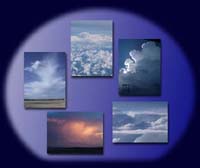Subsun
|
If ice crystals float in the air below the altitude of the observer, the sun can be pictured by reflection at these crystals. A bright spot appears in the air. For this effect the sun has to be in the same direction above the horizon and its reflection has the same distance below the horizon as the sun itself above it. Mostly the ice crystals are hexagonal platelets hence they float horizontally in the air as long as the atmosphere is not too turbulent. The sun is mainly reflected at the large, flat surfaces of the ice crystals which act like small mirrors. |
This effect is similar to the one that causes sun pillars. Since the background of this image is a stratus cover the picture of the sun cannot be confused with a reflection from the ocean surface. Also at the ground a similar effect can be observed as described in chapter Diamond Dust.
|
S. Borrmann, flight from Frankfurt to Philadelphia, 6 December
2004, 2:04 p.m. Camera Parameters Olympus E-1 SLR with 14-54 mm objective. Time of Exposure and
Sensitivity choice (400 ASA) was performed by camera automation.
The image was taken in a sRGB colour range with a resolution of
2560 x 1920 Pixel x 24 colours, Lens Aperture 11, Time of Exposure
1/2500, Focal length 50 mm, 2:33:52 p.m.
|
![]()

